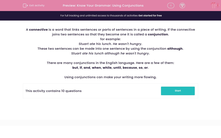A connective is a word that links sentences or parts of sentences in a piece of writing. If the connective joins two sentences so that they become one it is called a conjunction.
for example:
Stuart ate his lunch. He wasn't hungry.
These two sentences can be made into one sentence by using the conjunction although.
Stuart ate his lunch although he wasn't hungry.
There are many conjunctions in the English language. Here are a few of them:
but, if, and, when, while, until, because, so, or.
Using conjunctions can make your writing more flowing.








